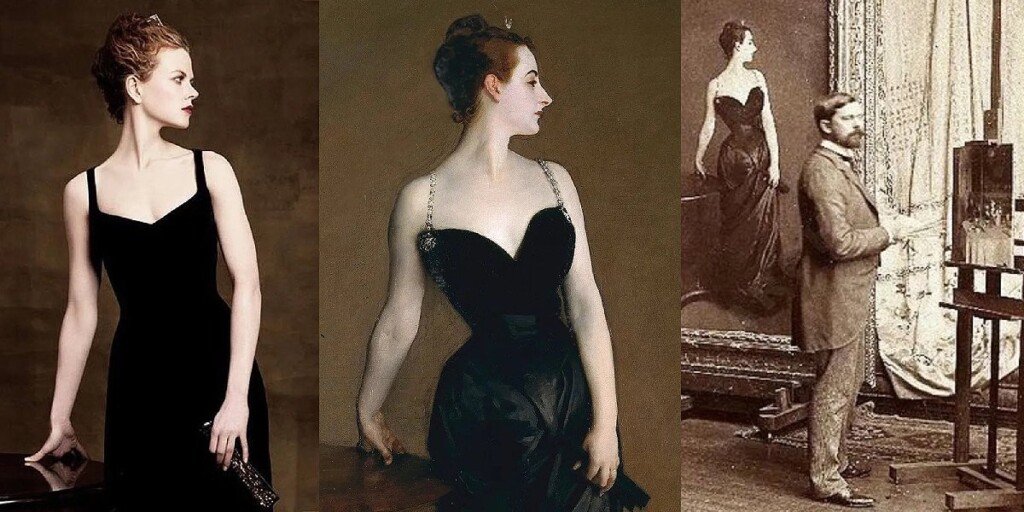Introduction: Why This Painting Matters to This Day
Few works in art history have had the power to fascinate. Few can incite temperament like the Portrait of Madame X by John Singer Sargent. This portrait was painted in 1884. Now an icon, it was received with shock and condemnation at the time. It depicted Virginie Amélie Avegno Gautreau. Today, it is an example of bold individual expression and timeless artistic skill.
This article offers a personal yet informative commentary. It unpacks the painting’s history. It also examines its relevance to today’s art lovers. It looks at why cultural observers are interested. It provides insights for anyone eager to understand complex issues surrounding beauty and identity.
This is the article for you. It suits those embarking on their very first leg into art history. It is also for those returning to an old favorite. Let’s understand why Portrait of Madame X continues to attract attention, more than a century after it first came out.

John Singer Sargent, A Cosmopolitan by Sunshine
John Singer Sargent was born to American parents in Florence and was a true citizen of the world. All his life, he lived midst the cultural capitals of Europe. He imbibed the sophistication of art in that old world. His work merged that raw spirit of experimentation and boldness characteristic of Americans. By the time he reached his late twenties, he had created an identity for himself. He became a very eminent portraitist. He was known for brilliance in technique and insight in psychology.

Masterful control of light, painterly brushwork, and the capacity to make subjects both real and elevated defined Sargent’s style. He painted not just how people looked. He captured who they were, or at least who they wanted the world to see. An ideal theme popped into his path with Portrait of Madame. Sargent’s audacious artistic instincts matched charismatically with the theme before him.

The Woman Behind the Scandal: Virginie Amélie Avegno Gautreau
Madame Gautreau was not that faithful muse classic. She was a born-in-Louisiana socialite now married to a Parisian banker. She was primarily known in elite circles for her exotic beauty, eccentric style, and rumored amorous affairs. Her lavender-powdered skin added to her allure. Her dashing outfits and mysterious charm made her the topic of admiration and gossip.
Sargent was impressed by her enigmatic beauties. He sought to get his brush around her, not under commission but out of artistic temptation. He found within her the very modern symbol of femininity-a tension between elegance and audacity that he sought to catch. Thus conjured was a portrait like no other-composed, provocative, and completely bold.

A Detailed Look at the Composition: What Makes It Unforgettable
Let us consider the elements of Portrait of Madame X that make it so wearable in this lifetime for the visual-emotional experience:
The Pose and Body Language
Madame Gautreau is positioned next to a shiny and polished surface. Her body has a slight twist to give movement and drama. Her right arm rests atop the table. Her left arm hangs loosely from the side. Her head tilts away from the viewer. In effect, she isn’t looking toward us but isn’t inviting our gaze; she’s indifferent to it. Thus, there is a distance visual barrier from which she seems to float, making her untouchable and magical.
The Dress
She was adorned in an ebony satin gown. It was bedecked with jeweled straps. The neckline was so low that it was said to be indecent. Originally, one strap from the gown painted slipped off her. So, it caused scandal among those in Paris in 1884. Although Sargent later repainted the strap to look more secure, this is still a daring dress even by current standards. This complements her pale skin and underlines a confident, even defiant presence.
Light and Color
Set against a dark and greatly simplified background, the light and form contrast the pale skin of the model. Sargent restricts himself to blacks, whites, and muted earth tones for his back-and-forth with the sittings. The illumination is soft but precise. It highlights the powdered skin texture and a subtle shimmer to the gown. Her face and arms almost glow. Combining delicacy and strength, those two features give an impression of the model being veiled by light.
Symbolism and Style
Though painted with realism, it leans toward symbolism in the portrait. Madame Gautreau is much more than herself. She becomes a statue of womanhood, of mysteries, and of the social tensions of the Belle Époque. There are no props or heavy background. We are forced to confront her directly. This emphasizes her as an individual rather than as an ornament of society.

The Public Reaction: Outrage and Reputation
When at the Paris Salon in 1884, Portrait of Madame X generated an incredible and furious public outburst. The pose and the costume were labeled indecent and obscene by audiences and critics alike. Madame Gautreau’s reputation elevated the perception that she was flaunting her erotic desires. This drove the painting into a public spectacle.
Sargent painted what he thought was an impressive and dignified portrait. He was sufferably bruised. His career suffered the most. He refused to take the painting out of the show, but he did make improvements to silence his disgruntled critics.
The strap of the dress was repainted, but the original version can still be glimpsed by x-ray examination. A distinct underlying layer shows the difference between the original and the current state of the artwork. This was observed when examined under X-rays.
In the end, the uproar pushed him to England and later to the United States. His career would eventually blossom anew in those countries.
We view the scandal today not as something negative about the painting, but as a measure of its potency. It sparked debate around propriety and beauty and the place of women in public life-things still very much alive today.
Why This Painting Still Resonates
More than a century later, Portrait of Madame X is admired for the very qualities that were condemned back in its time. It speaks about much greater themes that have transcended beyond its own time:
- Confidence and Identity: Madame Gautreau is portrayed as self-possessed. She is unapologetically herself. This portrayal is a bold statement of autonomy for the women of that era.
- Beauty and Social Norms: The painting invites us to re-evaluate what is considered beauty. It challenges us to consider how beauty is policed by society. Once viewed as scandalous, now considered tasteful.
- Art as a Catalyst for Conversation: The painting reminds us that genuine art is not always comforting. It interrupts, irritates, and is prone to multiple interpretations.

Even in current times, the resonance of this impact runs through the vein of contemporary culture. In 1999, actress Nicole Kidman posed in a recreation of the image. This was for the camera of Steven Meisel. It was a tribute to the longevity of the portrait. It also celebrated the continued intrigue of its theme.

Final Reflections: What to Look For When You See It
On your next museum visit, take a good look at the Portrait of Madame X. Alternatively, you can do this with whatever access you have to a textbook. Watch how her pale skin glows against the background. Notice the subtle turn of her shoulder. Appreciate the elegant calculation of the gown. How does the painting affect you? Are you drawn in or held away? That wonderful tension is what makes the painting unforgettable.
Portrait of Madame X is much more than a mere portrait. It reflects changing societal ideals. It serves as a time capsule of the Belle Époque. It is also a timeless proclamation of individuality.
If You Like This Article
Check out my earlier personal commentary on Sir Francis Bernard Dicksee’s La Belle Dame sans Merci. It continues the dialogue about beauty, storytelling, and emotion in painting.

A Personal Commentary on Sir Francis Bernard Dicksee’s La Belle Dame sans Merci
Explore Sir Francis Bernard Dicksee’s masterpiece, which was inspired by Keats’s poem. Uncover its rich symbolism of love, enchantment and betrayal. This painting portrays love, enchantment, and tragedy with a riot of color and intricate symbolism, emotionalizes it with depth.
Thank you for reading, and you continue to navigate the force of art, your way.
Written by Discoverer of ART
Editor, curator, publisher
Twitter (X) – @DesignResource_





